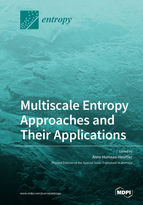Multiscale Entropy Approaches and Their Applications
A special issue of Entropy (ISSN 1099-4300). This special issue belongs to the section "Multidisciplinary Applications".
Deadline for manuscript submissions: closed (15 October 2019) | Viewed by 96545
Special Issue Editor
Interests: entropy; multiscale entropy; nonlinear analysis; empirical mode decomposition; biomedical data
Special Issues, Collections and Topics in MDPI journals
Special Issue Information
Dear Colleagues,
Multiscale entropy measures have been proposed from the beginning of the 2000s to evaluate the complexity of time series, by taking into account the multiple time scales in physical systems. Since then, these approaches have received a great deal of attention and have been used in a large range of applications. Multivariate approaches have also been developed.
The algorithms for a multiscale entropy approach are composed of two main steps: i) a coarse-graining procedure to represent the system’s dynamics on different scales; ii) the entropy computation for the original signal and for the coarse-grained time series to evaluate the irregularity for each scale. Moreover, different entropy measures have been associated with the coarse-graining approach, each one having its advantages and drawbacks: approximate entropy, sample entropy, permutation entropy, fuzzy entropy, distribution entropy, dispersion entropy, etc.
In this Special Issue, we would like to collect papers focusing on both the theory and applications of multiscale entropy approaches. Any kind of entropy measure is considered (see above).
The main topics of this Special Issue include (but are not limited to):
- improvement of the coarse-graining concept
- improvement in the entropy measure itself
- applications of the multiscale approach on univariate or multivariate time series; one-dimensional, but also bi-dimensional data are welcome. Applications can include biomedical engineering, chemical engineering, hydrology, pharmaceutical sciences, financial analyses, neurosciences, industrial engineering, geosciences, information sciences, etc.
This issue is to continue with the first issue of Multiscale Entropy,
https://www.mdpi.com/journal/entropy/special_issues/multiscale_entropy
Dr. Anne Humeau-Heurtier
Guest Editor
Manuscript Submission Information
Manuscripts should be submitted online at www.mdpi.com by registering and logging in to this website. Once you are registered, click here to go to the submission form. Manuscripts can be submitted until the deadline. All submissions that pass pre-check are peer-reviewed. Accepted papers will be published continuously in the journal (as soon as accepted) and will be listed together on the special issue website. Research articles, review articles as well as short communications are invited. For planned papers, a title and short abstract (about 100 words) can be sent to the Editorial Office for announcement on this website.
Submitted manuscripts should not have been published previously, nor be under consideration for publication elsewhere (except conference proceedings papers). All manuscripts are thoroughly refereed through a single-blind peer-review process. A guide for authors and other relevant information for submission of manuscripts is available on the Instructions for Authors page. Entropy is an international peer-reviewed open access monthly journal published by MDPI.
Please visit the Instructions for Authors page before submitting a manuscript. The Article Processing Charge (APC) for publication in this open access journal is 2600 CHF (Swiss Francs). Submitted papers should be well formatted and use good English. Authors may use MDPI's English editing service prior to publication or during author revisions.







